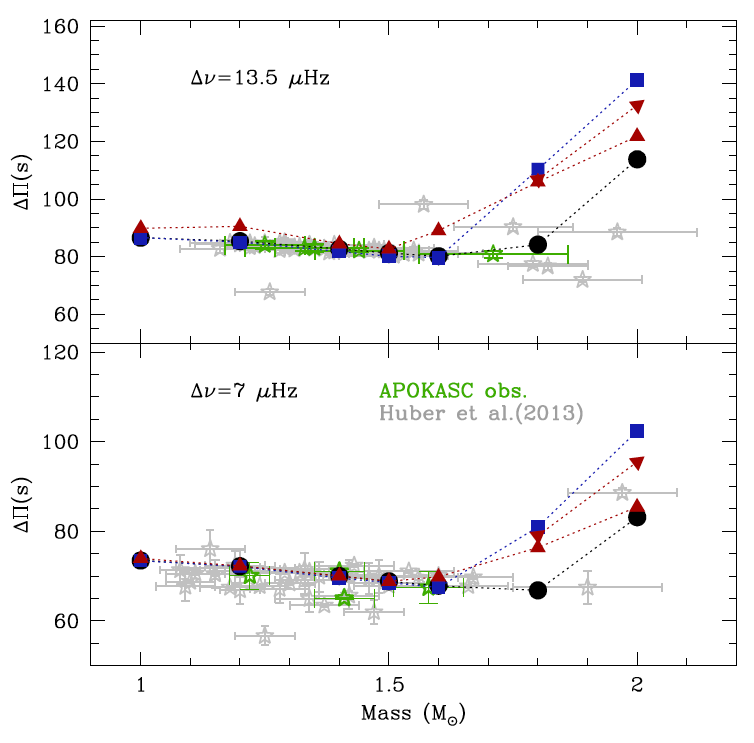Asteroseismology to constrain stellar evolution
CoRoT Giant Stars
- Lagarde N., Miglio, A., Eggenberger, P., Morel, T., Montalbán, J., Mosser, B., et al. 2015, A&A, 580, A141 “Atmospheric parameters and chemical properties of red giants in the CoRoT asteroseismology fields”
- Morel T., Miglio A., Lagarde N., et al. 2014, A&A, 564, A119 “Models of red giants in the CoRoT asteroseismology fields combining asteroseismic and spectroscopic constraints - The open cluster NGC 6633 and field stars”
- Szigeti L., et al. 2018, MNRAS, 474, 4810 “12C/13C isotopic ratios in red-giant stars of the open cluster NGC 6791”
Context: One of the groundbreaking results of asteroseismology has been the detection of solar-like non-radial oscillations in red giant stars. On the one hand, these observations have paved the way for detailed studies of the internal structure of giant stars, providing unique and revolutionary tests of current models of stellar evolution. On the other hand, the development of large spectroscopic surveys provides detailed and precise chemical properties of stars. Results: I studied one of the first samples of CoRoT giant stars for which spectroscopic observations were available. This pioneering work, combining spectroscopic and asteroseismic constraints, reveals the very good agreement between my models of stellar evolution and the chemical and seismic properties observed. It contributes to a finer understanding of stellar structure and evolution. Finally, in 2018, I took part in the interpretation of the abundances observed on the surface of giant stars belonging to the NGC6791 cluster observed by the APOGEE and Kepler spectroscopic survey; using my stellar evolution models including mixing. We were able to show that the spectroscopic observations added to the seismic constraints could be explained by stellar evolution models including thermohaline mixing on the red giant branch.

The core of giant stars
- Lagarde, N., Bossini, D., Miglio, A., Vrard, M., Mosser, B. 2016, MNRAS, 457, L59 “Testing the cores of first ascent red-giant stars using the period spacing of g modes”
- Mosser, B., Benomar, O., Belkacem, K., Goupil, M.J., Lagarde N., et al. 2014, A&A, 572, L5 “Mixed modes in red giants: a window on stellar evolution”
Context: Asteroseismology has also been widely used to estimate stellar properties (e.g. stellar mass, radius, and distance), providing a fundamental contribution to the characterization of planet hosting stars (e.g. Huber et al. 2013; Johnson et al. 2014) and stellar populations (Miglio et al. 2013). Rotation and convective-core overshoot are two examples of a number of key processes that change all the outputs of stellar models, with a significant impact on asteroseismic observables (e.g. Eggenberger et al. 2010; Lagarde et al. 2012; Montalban et al. 2013; Bossini et al. 2015; Constantino et al. 2015). Consequently, transport processes can have a significant impact on the determination of planet and star masses.
Results: In the context of the determination of stellar properties using asteroseismology, we study the influence of rotation and convective-core overshooting on the properties of red-giant stars. We used models in order to investigate the effects of these mechanisms on the asymptotic period spacing of gravity modes ( \Delta \Pi_{\ell=1} ) of red-giant stars that ignite He burning in degenerate conditions ( M\lesssim 2.0M_\odot). We also compare the predictions of these models with Kepler observations. For a given \Delta \nu , \Delta \Pi_{\ell=1} depends not only on the stellar mass, but also on mixing processes that can affect the structure of the core. We find that in the case of more evolved red-giant-branch (RGB) stars and regardless of the transport processes occurring in their interiors, the observed \Delta \Pi_{\ell=1} can provide information as to their stellar luminosity, within ~10-20%. In general, the trends of \Delta \Pi_{\ell=1} with respect to mass and metallicity that are observed in Kepler red-giant stars are well reproduced by the models.

Rotation in giant stars
- Eggenberger P., Lagarde N., et al. 2017, A&A, 599, A18 “Constraining the efficiency of angular momentum transport with asteroseismology of red giants: the effect of stellar mass”
- Eggenberger P., Lagarde N., et al. 2016, Astronomische Nachrichten, 337, 832 “Models of rotating stars constrained by asteroseismic measurements of red giants ”
- Eggenberger P., et al. 2019, A&A 621, A66 “Asteroseismology of evolved stars to constrain the internal transport of angular momentum. I. Efficiency of transport during the subgiant phase ”
- Mathis S. et al. 2018 A&A 620 A22 “Anisotropic turbulent transport in stably stratified rotating stellar radiation zones”
Context: The detection of split mixed modes under the effect of rotation makes it possible to probe the rotation rates of the cores of giant stars. However, these observations show a disagreement between the observed rotation rates and those predicted in the cores of giant stars (e.g., Beck et al 2012), requiring an improvement in the physics related to rotation or the inclusion of an additional momentum transport process occurring in stellar interiors. Results: The first three studies determined the physical properties of an additional process and highlighted the differences with rotation as included in current stellar evolution models, using a parametric model and both spectroscopic and seismic data. The aim of the 4th study was to perfect the description of turbulence and to include this new requirement in stellar evolution models. These projects are essential for a better understanding of the physics of angular momentum and chemical transport processes in stars.